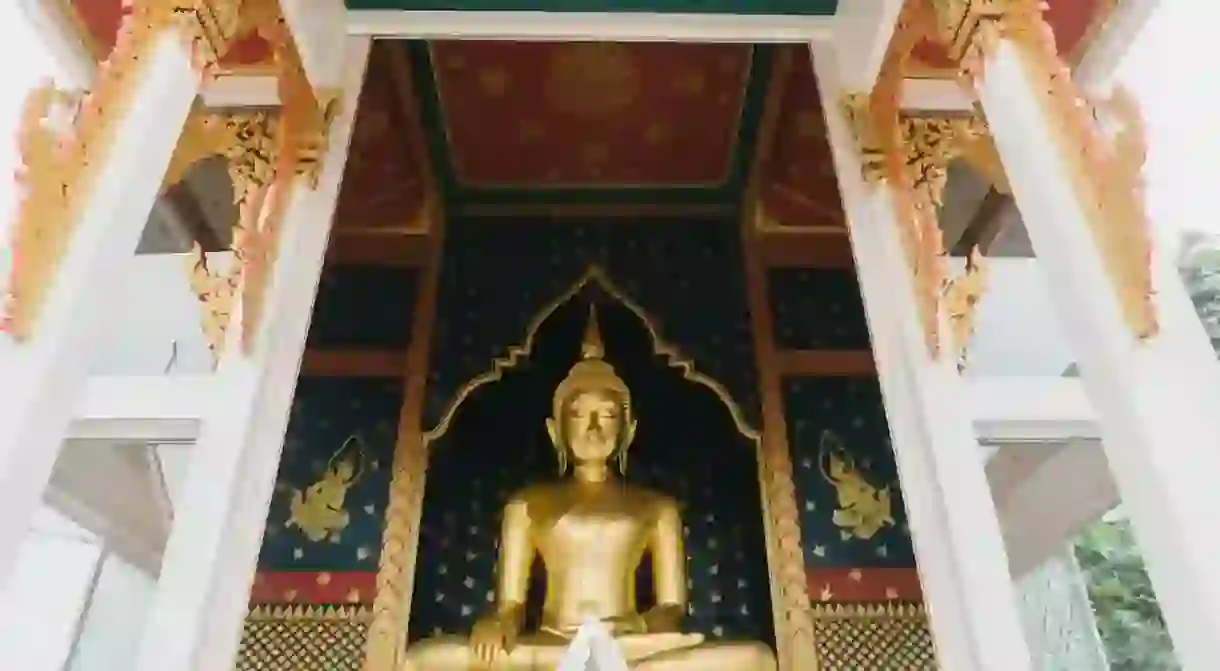A Guide To Bangkok's Wat Saket

Wat Saket, also known as the Golden Mount, is one of Bangkok’s major temples. A revered site for locals and a popular tourist attraction, here’s everything you need to know about this beautiful temple.
Wat Saket features an artificial hill, topped with a 5.8-metre-tall golden chedi. The chedi is visible from far and wide as it glints in the sunshine. It’s hard to believe today with Bangkok’s many modern skyscrapers, but the 80-metre-tall hill was once the highest point in the city!

The temple dates back to the Ayutthaya period, though there have been several alterations to it over the ages. The hill is part of the larger temple complex, though it is by far the most visited and most recognised aspect. It was added many years after the original temple was founded.
Known as Phu Khao Thong, or the Golden Mountain, the hill actually collapsed in the past, standing overgrown and abandoned for several years. Interestingly, it wasn’t reinforced with concrete until the 1940s; previously it was just logs and earth.


At the bottom of the hill is an old and rather creepy cemetery from the times when the temple was used as a mass burial ground for victims of the plague. You’ll also find the monks’ living quarters and the main part of the temple at ground level.
There are plenty of places to stop for a break as you make the climb and the walkway is lined with interesting statues to occupy your mind in the heat. There are also bells that Thai Buddhists ring for good luck. At the top of the Golden Mount you’ll be greeted by glorious panoramic views over Bangkok that will make the effort more than worthwhile!


You’ll notice more small bells with messages written on hearts hanging underneath. Originally, written notes were a way to pay respect to the temple and to seek blessings for particular people. It was common for people to note down the names of sick family members, for example, as a way to try and aid their recovery. Nowadays, many visitors leave messages as a mark of having visited the temple. Think of it almost like a prettier version of a guest book!


There are larger bells and gongs too; ringing these is another way that Buddhists seek good luck.


Numerous religious statues are scattered throughout the temple, showing the Lord Buddha in various postures. Trees and flowers add to the serene air, even if the site is buzzing with tourists. Don’t miss seeing the sacred Bodhi trees, the same type of tree that Siddhartha Gautama (Buddha) was sitting under when he attained enlightenment.



The golden chedi houses a relic of the Lord Buddha. The relic was brought to the temple from Sri Lanka in the late 1800s. Locals come here to pray, make merit, and seek blessings.



Offerings of flower garlands, lotus buds, incense, and money are common.


Wat Saket attracts many pilgrims in November. Held at the same time as Loy Kratong, the nine-day celebrations include a beautiful candlelit procession up the hill and a ceremony to honour the sacred relic. The chedi is wrapped in a vibrant red cloth and there are many colourful lanterns and prayer flags. The surrounding area is abuzz with food vendors, carnival-like games, craft stalls, and funfair rides.




Wear comfortable shoes and take a bottle of water with you to visit the temple — getting to the top requires climbing around 300 steps! Try to visit in the early morning or late afternoon to avoid the hottest periods of the day. Do also remember to dress appropriately for a place of worship. If you plan to visit for the November temple fair, arrive early. The queues just before sunset can be incredibly long!














